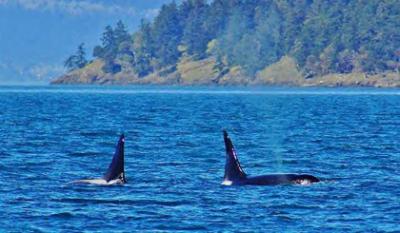
Bromance

Earth Month brought an orca bloom to Vashon. Multiple groups of killer whales visited Island waters. In mid-April, two distinct ecotypes traversed the territory, gingerly avoiding each other. Southern Resident K Pod commuted through Colvos Pass while Transients meandered through East Pass. Late in the day on April 14, both ecotypes were in the Tacoma Narrows, separated by mere hours.
I expect to see Transients here in April; however, in my 20 years on Vashon, I have never seen K Pod here in April. In early spring, K Pod usually forages for salmon in coastal waters between Washington and central California. That these 19 endangered orcas came into Puget Sound from the ocean is perplexing. Perhaps coastal prey resources are meager this year. Evidently, the fish chasers did not find great eats here, either. K Pod headed out to sea again on April 15. Researchers saw no new babies.
K Pod’s foray into the Sound was brief possibly due to the influx of various Transient groups. The Resident orcas were somewhat subdued; the Transients were rather flamboyant. Chez VHP particularly enjoyed observing the exploits of two adolescent Transient males: T49C, age 16, and T77A, age 18. Though they are not blood relatives, their camaraderie calls to mind interactions between closely related Southern Resident males. Our Dos Amigos, T49C and T77A, have a “bromance.”
We watched the handsome dudes for several hours as they cavorted off Point Defiance Park. The two were often within touching distance of one another -- traveling side-by-side, hunting cooperatively, doing synchronized tail slaps. Though they are technically still sprouters (sub-adults), T49C and T77A are already the size of full-grown Resident males.
Some mature Transient males are enormous. For example, 36-year-old Rainy, T011A, is a contender for biggest male in the West Coast Transient community. T011A was among the killer whales traveling north in East Passage on the morning of April 15. To see stunning photos of Rainy and other Transients, look up The Transient Killer Whale Research Project online.
Someday, our Dos Amigos could grow to the size of T011A. Careful study reveals that T77A, the older Amigo, is a bit larger than T49C. From Friday Harbor to Eld Inlet near Olympia, T49C and T77A proved how photogenic they are. Dubbed “the Twins” online for nearly identical nicks in the trailing edges of their dorsal fins, these orcas roamed all over the Salish Sea in mid-April. This week’s photo stokes my nostalgia for San Juan Island and our lovely “bros.”
Regrettably, an unwelcome consequence of the Twins’ popularity was obnoxious boat behavior. We witnessed it near Tacoma: numerous vessels converging on just two orcas, and a loud, fast-moving tug that made a beeline for T49C and T77A. The Boys appeared perturbed by that tugboat. Report harassment to NOAA at 1-866-767-6114.
Many Transients identified in Vashon-Maury waters this spring are newcomers; e.g., the T011s; T49C and T77A. The T011s accompanied the T137s, a group I saw here previously. Note that these orcas are entirely different from the Transients I wrote about in the 4/10/14 edition of The Loop. During Earth Month, we have been blessed with an abundance of Kéet.
In our First Nations household, every day is Earth Day. Truthfully evaluate your ecological footprint while the non-Indigenous world also celebrates Mother Earth during April. The human tendency toward perpetual denial imperils our sacred whales and our planet.
Please support the work of the Vashon Hydrophone Project (VHP): REPORT LOCAL WHALE SIGHTINGS ASAP TO 206-463-9041, as well as seal pups and sick, injured, or dead marine mammals on Island beaches. Prompt reports to the VHP expedite vital data collection efforts and sustain an accurate record of whale sightings for Vashon-Maury. Send photos to Orca Annie at Vashonorcas@aol.com
- Login to post comments
